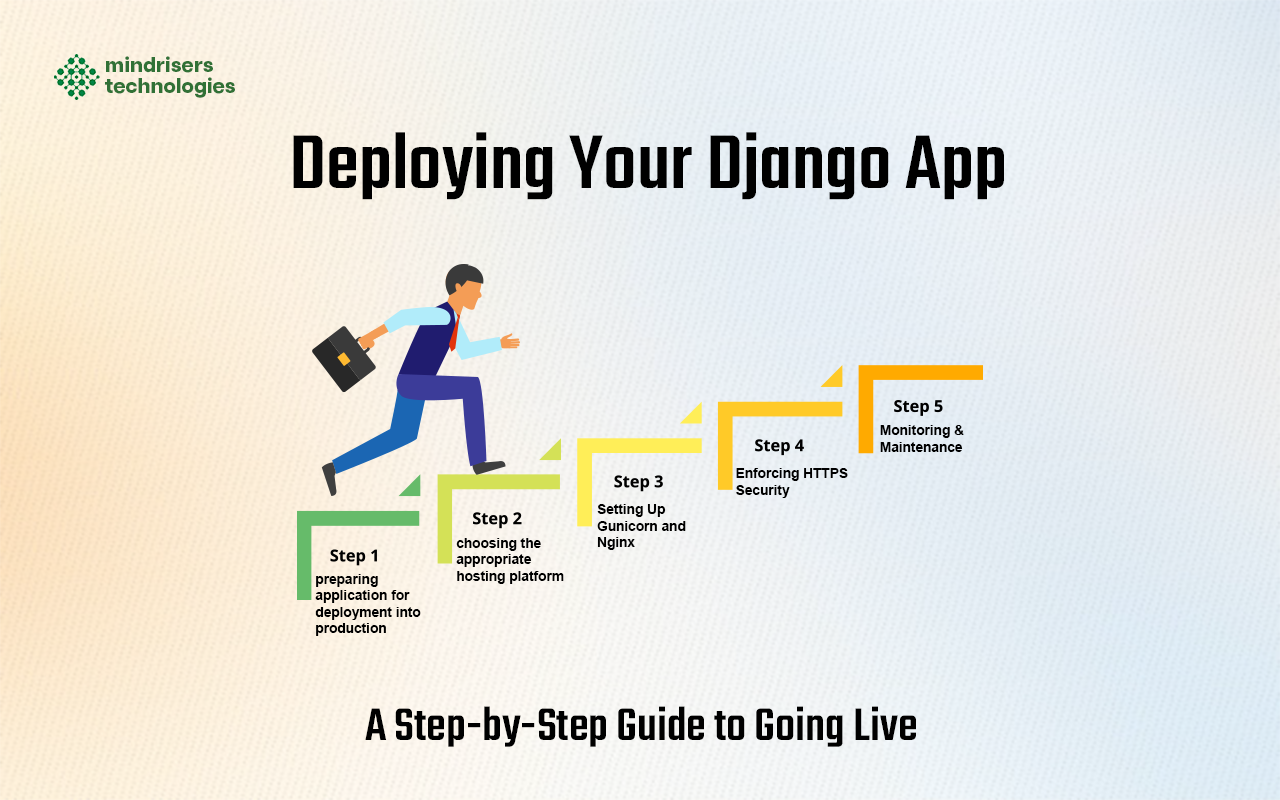
Alisha Karki - Author
2025-04-06
A production deployment of your Django app marks a major professional achievement that needs precise preparation. A live environment requires security alongside scalability and reliability because it differs from the local development server.
This guide provides step-by-step deployment instructions for Django apps on AWS EC2, Google Cloud, Heroku and Render while avoiding complex code examples.
The guide will teach you to safely deploy the Django application while enhancing performance levels and ensuring operational stability for live website traffic.
Why Proper Deployment Matters
Running a Django app in production is very different from using the built-in development server. The runserver command is great for testing, but it’s not designed for real-world traffic. Here’s what changes when you go live:
- Security Risks: Debug mode exposes sensitive data, so it must be turned off.
- Performance Bottlenecks: A single-threaded development server can’t handle multiple users.
- Static & Media Files: Django doesn’t serve these efficiently in production, you need a web server like Nginx.
- The requirement for HTTPS represents a modern necessity because websites need SSL/TLS encryption to maintain security.
The following requirements will help you address these issues:
- Gunicorn (or uWSGI) as an application server.
- Nginx as a reverse proxy and static file handler.
- A cloud provider (AWS, Google Cloud, Heroku, etc.).
The following guide explains how to perform a successful deployment.
The first step involves preparing your Django application for deployment into production.
Before moving to a live server, make sure your app is optimized for production:
Disable Debug Mode
The first rule of deployment: Never run with DEBUG = True in production. This setting exposes error details, database queries, and other sensitive data. Switch it off in your settings.py file.
Set Up ALLOWED_HOSTS
This security feature prevents HTTP Host header attacks. List only the domains where your app will run, including both the root domain and www subdomain.
Move the Secret Key to Environment Variables
Hardcoding your SECRET_KEY in settings is risky. Instead, use environment variables or a tool like python-dotenv to keep it secure.
Configure Static and Media Files
The collectstatic command from Django consolidates static files into a single directory yet Nginx provides the most efficient method to serve these files. Set the STATIC_ROOT value to point to /var/www/yourdomain.com/static/.
Choose a Production Database
The development process works well with SQLite databases while PostgreSQL or MySQL shows better results in production through their superior performance and dependability.
The second step involves choosing the appropriate hosting platform
Where should you deploy the Django app? Each platform has pros and cons:
AWS EC2 with Nginx (Best for Full Control)
Amazon EC2 delivers a robust virtual server which enables complete management of your environment. The setup process starts with launching either an Ubuntu or Amazon Linux instance. You need to install Python alongside Nginx and Gunicorn to manage your application.
The reverse proxy configuration of Nginx directs incoming requests to Gunicorn for efficient request processing. Secure communication becomes possible through the implementation of Let’s Encrypt for HTTPS setup. Users who prioritize server control along with scalability capabilities would find this solution to be the most suitable option.
Heroku (Simplest for Beginners)
The Platform-as-a-Service (PaaS) solution Heroku makes infrastructure management easier for users. The Git push method enables you to deploy your application through Heroku automatically.
With no server management required, you only need to configure a Procfile for Gunicorn. While a free tier is available, it comes with limited resources. This makes Heroku an excellent choice for small projects and quick deployments.
Google Cloud (Balanced Flexibility & Ease)
Google Cloud offers virtual machines through Compute Engine, similar to AWS.You can establish a VM and install Nginx and Gunicorn while using Cloud SQL for managed database services. You can enable automatic performance scaling of your applications through Google Cloud.
The platform provides scalability advantages of AWS systems while maintaining the straightforward operations available from Heroku solutions.
Render (Modern Alternative to Heroku)
Render is a popular platform known for its simplicity and free tier. It connects directly to GitHub for automatic deployments and includes a built-in PostgreSQL database.
With no complex server setup required, you simply define your app's requirements. It's perfect for developers seeking hassle-free hosting.
Step 3: Setting Up Gunicorn and Nginx
Why Gunicorn?
The Gunicorn WSGI server exists as a production-ready platform which efficiently handles numerous server requests. Gunicorn operates better than Django's development server as it enables the execution of worker processes for multiuser abilities alongside superior error loggers and Nginx server compatibility for enhanced system performance.
Why Nginx?
The Nginx reverse proxy system sends requests to Gunicorn while providing direct static file serving for improved performance and SSL/TLS encryption and load balancing capabilities for multiple server scalability.
Basic Nginx Configuration
The reverse proxy functionality of Nginx successfully directs incoming requests to Gunicorn while providing static content server capabilities at improved speeds compared to Django and SSL/TLS encryption and server load balancing features when operation reaches multiple servers.
Step 4: Enforcing HTTPS Security
Excellent search engine results from Google go to HTTPS domains while visitors see an "Not Secure" warning for unencrypted HTTP webpages. The following steps will guide you through website encryption.
Let’s Encrypt provides SSL certificates at no cost.
The Certbot system provides automated SSL certificate management through its ability to both deploy certificates and renew them before expiration dates while setting up Nginx to redirect users to secure HTTPS connections.
Your website should implement HTTP Strict Transport Security (HSTS) to protect users.
HTTPS security protocols receive instructions from this directive which stops attackers from using downgrade tactics.
Google ranks HTTPS sites higher, and browsers mark HTTP as "Not Secure." Here’s how to encrypt your site:
Get a Free SSL Certificate (Let’s Encrypt)
Certbot automates the SSL setup process by installing certificates, automatically renewing them before expiration, and configuring Nginx to handle HTTPS redirects for secure connections.
Enable HTTP Strict Transport Security (HSTS)
This tells browsers to always use HTTPS, preventing downgrade attacks.
Secure Headers for Extra Protection
The security of websites appreciates greatly due to headers which include Content-Security-Policy (CSP) and X-Content-Type-Options and X-Frame-Options because these headers halt malicious scripts while stopping MIME sniffing and blocking clickjacking attacks.
The implementation of these steps creates a barrier against typical web security threats.
Step 5: Monitoring & Maintenance
Check Server Logs
- Nginx logs (/var/log/nginx/) track requests and errors.
- Gunicorn logs show app-level issues.
Set Up Automated Backups
- Database backups (daily if possible).
- Code backups (Git repositories).
Scale as Needed
- Vertical Scaling: Upgrade server resources (CPU, RAM).
- Horizontal Scaling: Add more servers + load balancing.
Final Checklist Before Going Live
Before announcing your app, ensure that debug mode is off, static files are properly served, HTTPS is enforced, database backups are scheduled, and error monitoring is in place (e.g., Sentry) for effective troubleshooting and security.
Conclusion
Deploying a Django app doesn’t have to be intimidating. Whether you choose AWS for full control, Heroku for simplicity, or Render for a modern alternative, the key steps are similar.
First, prepare your app by ensuring security, serving static files correctly, and setting up the database. Then, choose a hosting provider based on your specific needs. Set up Gunicorn and Nginx to optimize performance, and secure your app with HTTPS using Certbot and Let’s Encrypt.
Finally, monitor your app and scale it as traffic grows. With these steps, you’re ready to deploy your Django app with confidence. Happy hosting! 🚀
FAQ
Can I deploy Django for free?
Yes! Heroku and Render offer free tiers, though with limitations.
Is AWS overkill for a small project?
If you expect growth, AWS is great. For simple apps, Heroku or Render may suffice.
How often should I update dependencies?
Regularly! Use pip list --outdated to check for updates.
Recent Post
View All
Complete Roadmap to Become a Full Stack Python Developer
2025-10-14.683 Views
How Local Businesses in Nepal Can Use WhatsApp Marketing Effectively
2025-08-18.1323 Views
AI Tools Every Students Should Know in 2025
2025-08-18.1360 Views
How Programmers Can Overcome Bug Overload Effectively
2025-08-17.1179 Views
Never miss an Opportunity !
Want to learn TOP 2025 IT Skills ?
We open IT skill classes Monthly in Design, Development, Deployment, Data etc.
Have something to Ask ?
get admission enquiry